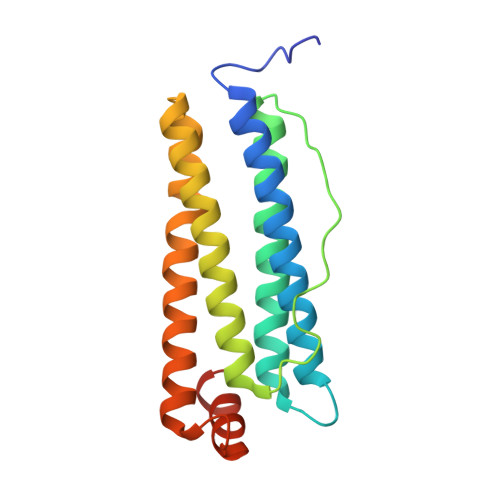A new and efficient procedure to load bioactive molecules within the human heavy-chain ferritin nanocage.
Lucignano, R., Stanzione, I., Ferraro, G., Di Girolamo, R., Cane, C., Di Somma, A., Duilio, A., Merlino, A., Picone, D.(2023) Front Mol Biosci 10: 1008985-1008985
- PubMed: 36714262
- DOI: https://doi.org/10.3389/fmolb.2023.1008985
- Primary Citation of Related Structures:
8A2L, 8A2M, 8A5N - PubMed Abstract:
For their easy and high-yield recombinant production, their high stability in a wide range of physico-chemical conditions and their characteristic hollow structure, ferritins (Fts) are considered useful scaffolds to encapsulate bioactive molecules. Notably, for the absence of immunogenicity and the selective interaction with tumor cells, the nanocages constituted by the heavy chain of the human variant of ferritin (hHFt) are optimal candidates for the delivery of anti-cancer drugs. hHFt nanocages can be disassembled and reassembled in vitro to allow the loading of cargo molecules, however the currently available protocols present some relevant drawbacks. Indeed, protein disassembly is achieved by exposure to extreme pH (either acidic or alkaline), followed by incubation at neutral pH to allow reassembly, but the final protein recovery and homogeneity are not satisfactory. Moreover, the exposure to extreme pH may affect the structure of the molecule to be loaded. In this paper, we report an alternative, efficient and reproducible procedure to reversibly disassemble hHFt under mild pH conditions. We demonstrate that a small amount of sodium dodecyl sulfate (SDS) is sufficient to disassemble the nanocage, which quantitatively reassembles upon SDS removal. Electron microscopy and X-ray crystallography show that the reassembled protein is identical to the untreated one. The newly developed procedure was used to encapsulate two small molecules. When compared to the existing disassembly/reassembly procedures, our approach can be applied in a wide range of pH values and temperatures, is compatible with a larger number of cargos and allows a higher protein recovery.
Organizational Affiliation:
Department of Chemical Sciences, University of Naples Federico II, Naples, Italy.

















